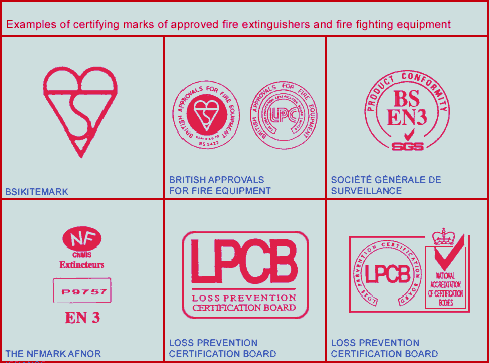All fire extinguishers, regardless of their age and type, must be independently verified to a high standard of manufacturing quality and performance. They must all be marked with one or more of these certifying marks:
- the BSI Kitemark
- the British Approvals of Fire Equipment (BAFE) symbol
- the Société Générale de Surveillance (SGS) symbol
- the AFNOR 'NF' shield
- the Loss Prevention Certification Board (LPCB)
- or other accredited certifying body's mark to EN3

| When an examiner checks the condition of fire fighting equipment on board, here are some examples of what he's looking for which you can check on a regular basis. Fire extinguishers must be replaced if they have missing pins, dents, perished hoses, incorrect pressure or damage to the trigger assembly. [6.1] |
| Fire ratings are marked on modern portable fire extinguishers, for example 5A/34B. The fire rating is the measure of the ability of a fire extinguisher to fight a fire of a certain size. The bigger the number in the fire rating the bigger the fire on which the extinguisher has been tested. The letter in the fire rating indicates the class of fire on which the extinguisher has been tested. The “A” rating relates to fires involving paper, wood, textiles or fabric and the “B” class fires are fuelled by flammable liquids. |
| Whilst in a lock an outboard engine malfunctioned and burning petrol was thrown out, over and around the rear deck area and the surrounding water. The boat owner tried both portable fire extinguishers from the boat, however neither of them worked properly and the fire continued to burn. The owner of another boat in the lock used one of his extinguishers and the fire was put out. On inspection it was discovered that the two extinguishers originally used failed to work because they were not certified and had passed their expiry date. [6.1] |
